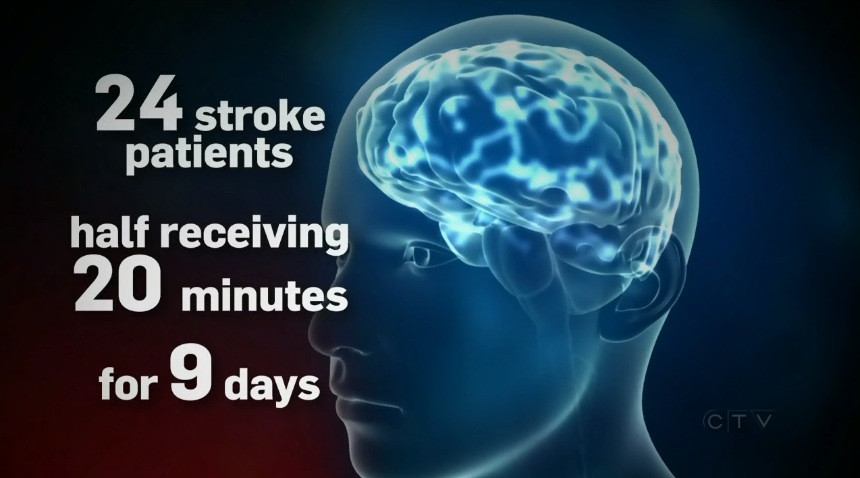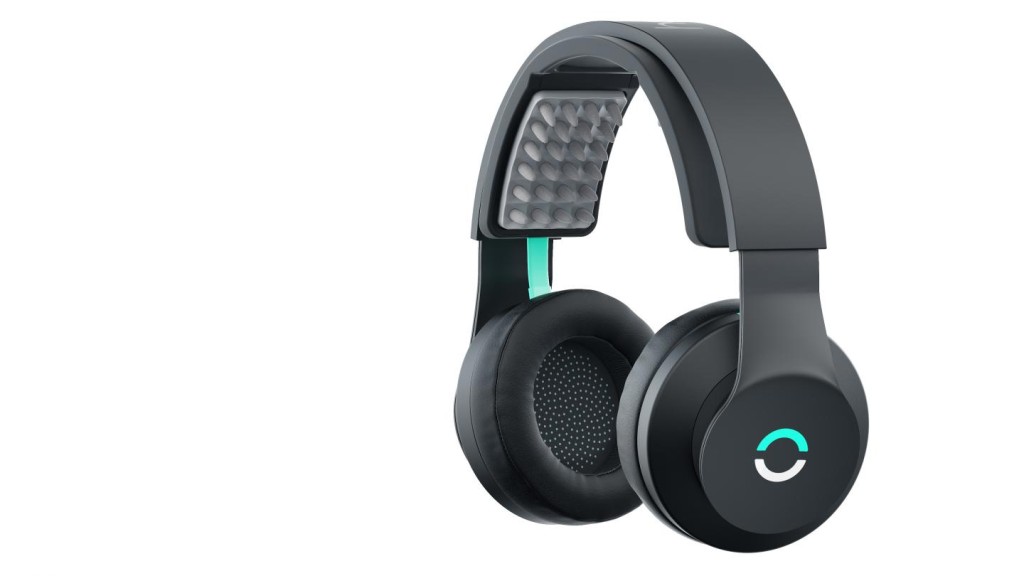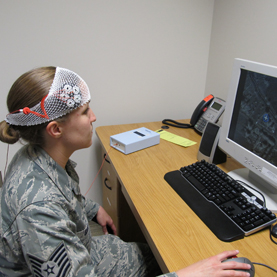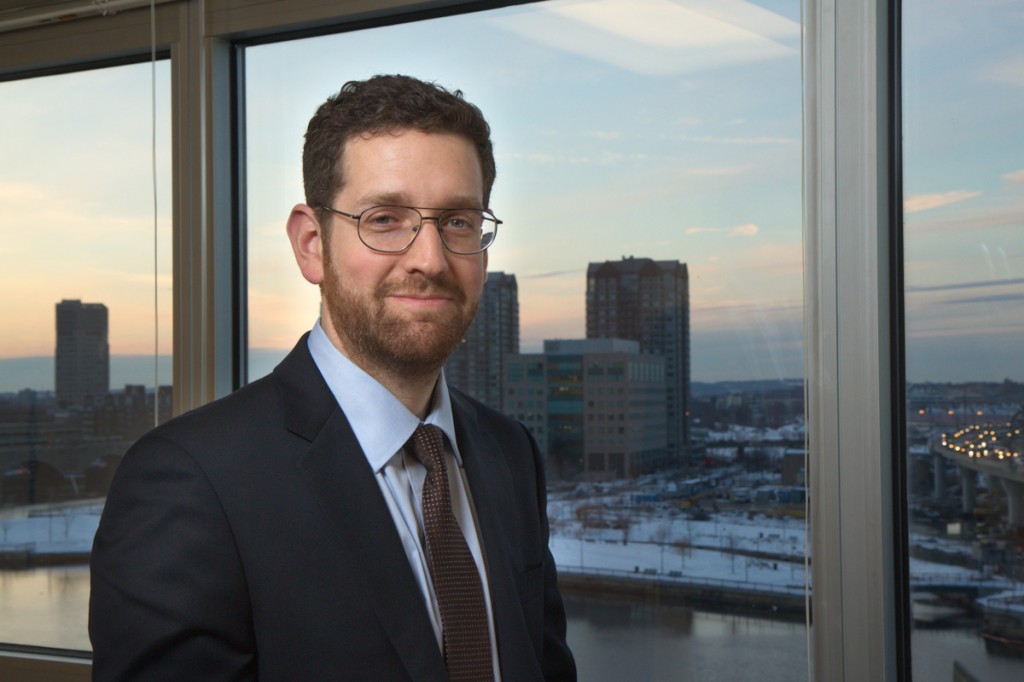Little information accompanies this video, but it appears to me that Karly Chapman is an Aphasia clinician demonstrating tDCS setup for fellow clinicians. She sets up for an Anomia treatment. It strikes me that a motivated family member wouldn’t have much trouble replicating this at home. Also that an online version would be a useful tool for clinicians and patients alike.
Tag Archives: stroke
Electrical brain stimulation can help recovery from stroke | CTV
Watch the CTV news story.
Dr. Alexander Thiel, director of the Comprehensive Stroke Centre at Montreal’s Jewish General Hospital, said the TDCS treatments have been studied before, but what’s special about the study out of Oxford is that it suggests the treatment may be causing structural changes in the brain that contribute to the patient’s recovery.
“This is important because it could either indicate that some parts of these nerve cells are able to regenerate, or these nerve cells try to form alternative pathways to reroute the traffic in the brain to a different route from the one that has been destroyed by the stroke,” he told CTV News.
Stroke patients in Canada can’t get TDCS therapy outside of a research study. But with several studies underway around the world, scientists hope they’ll be able to quickly confirm that brain stimulation has the power to accelerate stroke recovery.
Full article: Electrical brain stimulation can help recovery from stroke: study
Study: Ipsilesional anodal tDCS enhances the functional benefits of rehabilitation in patients after stroke
Study author: Charlotte Stagg
Halo Neuroscience Launches ‘Halo Sport’
Update 2/29/16. Halo Neuroscience launched the Halo Sport via ProductHunt. Details of the device are discussed in the comment section and includes input from CEO Daniel Chao and CTO Brett Wingeier. In a Medium article industrial designer Matty Martin talks about the challenges developing the Halo Sport. And, though not (yet anyway) peer reviewed, Halo Neuroscience has published the results of a few studies they’ve completed with the Halo Sport. Especially I found interesting Bihemispheric Transcranial Direct Current Stimulation with Halo Neurostimulation System Over Primary Motor Cortex Enhances Fine Motor Skills Learning in a Complex Hand Configuration Task (pdf).

We looked at Halo Neuroscience back in 2012, Halo Neuroscience – Amol Sarva, and knew they’d been testing a device for the last year. Today they announced the release of the Halo Sport which uses ‘neuropriming’ to increase athletic performance. At $549 it’s the most expensive neuro-device to come to market. It seems the target buyer is a high-end athlete.
Clicking on the get button takes you to two offers:
HALO SPORT PRO:
AVAILABLE TODAY
Halo Sport Pro is part of a service package designed for elite teams, trainers, and performance organizations.
and
HALO CHAMPIONS PROGRAM:
LIMITED CONSUMER RELEASE
Train like the pros. Be the first to pre-order Halo Sport and receive $200 off. Ships Fall 2016.
So I guess we’re in buzz-building mode, and the device will become available for anyone in the fall at around $349.
Follows is a clip from today’s Newsweek article. Click through to full story below.
As intriguing as the sports applications are, they only hint at what Halo might become. Chao says he will seek FDA approval to market Halo’s device as a way to help stroke victims recover their physical capabilities. And then, he says, a different version of Halo, which would send pulses into another part of the brain, will be able to improve memory and mental processing, giving users an advantage at work or school. At one point, he tells me some of Halo’s tests show it can “roll back cognitive aging by 25 years.” (He later seems to regret saying that, explaining that he prefers to stay focused on the sports applications.)
Halo Claims to Make You Jump Higher, Think Faster, Remember Longer
Dr. Michael Weisend on The Doctors TV
Known as transcranial direct current stimulation (tDCS), the process involves attaching electrodes to the skull and targeting specific areas of the brain with calculated jolts of electricity.
“The brain is an electrical organ, so it makes sense to try to manipulate what’s going on in the brain with electricity,” explains neuroscientist Dr. Michael Weisend.
tDCS Treatment with Severe Broca’s Aphasia
From The Aphasia Center at Steps Forward blog.
This treatment has been used thus far to examine naming in aphasia, apraxia treatment, and language recovery. Current studies in Italy have used this treatment for 20 minutes daily for 10 non-consecutive days, showing that clients keep the trained skills weeks to months after training. We use this treatment daily for 4-8 weeks while providing another 4 hours of treatment with great results thus far. It is unknown at this time what the best brain areas are for treatment, how long the best treatment lasts, how long the results last, and the optimum number of treatment sessions. Each person’s brain is set up slightly differently, so stimulating one area may have different effects for different people. This treatment is only offered to intensive program clients at this time since treatment/training must accompany stimulation and our results have all been from intensive clients.
Marom Bikson of Soterix Medical and CUNY – DIY tDCS Podcast Episode #3
Marom Bikson is CEO of Soterix Medical and Associate Professor at City College of New York in the Department of Biomedical Engineering. Marom is a distinguished tDCS scientist and prominent in the development of HD-tDCS. Download the interview here (zipped mp3). (Firefox users- there is an audio player here, but it’s displaying intermittently. Trying to track down the issue. In the meantime you can download the episode or open the page in another browser).
(We got a good forty minutes of interview in before the Skype gremlins caught up with us. I had to cobble an ending together.)
Show Notes:
Post-Doc, Neurophysiology Unit, University of Birmingham Medical School, U.K., 2003
Ph.D., Biomedical Engineering, Case Western Reserve University Cleveland, OH, 2000
B.S., Biomedical Engineering (EE Concentration), Johns Hopkins University, Baltimore, MD, 1995
Introduction to Transcranial Direct Current Stimulation (tDCS) in Neuropsychiatric Research
5th International Conference on Non-invasive Brain Stimulation 2013
Instrumentation – making medical gizmos, process.
IRB- Institutional Review Board
IRB at the FDA
Small Business Technology Transfer STTR grant.
Soterix partners
Abhishek Datta CTO,
Lucas Parra
Bootstrapped at this point.
Difficulty in engineering medical devices is in designing for the anomalous cases- how that 1 in 999 times situation could go wrong.
Clinical trials. Depression, (Colleen Loo, Blackdog Institute), pain, stroke, epilepsy clinical trials ongoing.
Customizing technologies to match needs of particular clinical situations.
Soterix developed software designed for clinicians.
HDTargeting
HDExplore
Modeling current flow through the head.
Perhaps depression studies are closest to FDA qualification for tDCS?
(Prediction is very hard, especially about the future – Yogi Berra.)
A device (NorDoc Smartstim) that can go to 4mA is being used in a smoking cessation trial? (Trial info indicates 2mA current dose.)
FDA tDCS approval would be device-specific at first. But would open the door to ‘me too’ mechanism, FDA 510(k)
HD tDCS can have multiple cathodes and or multiple anodes. An array of 4 small anodes splitting 2mA, for example (.5 mA each electrode), can function as an anodal ‘virtual pad’. Assumes cathode somewhere else on the body).

Image By Richard McKinley USAF
Tolerability is how tolerable in terms of side effects a medication is.
Transcutaneous Spinal Direct Current Stimulation Example tsDCS paper.
A Theory of tDCS (“Gross oversimplification”) As positive current flows into the cortex it passes neurons.
Because of the nature of neurons, this positive current depolarizes somas (cell’s body), increasing excitability, thereby increasing the functionality & plasticity of that region (hypothesis… “We really don’t know.”). Under the cathode, somas (cells) are being hyper-polarized – excitabilty decreases.
A synapse is a structure that permits a neuron (or nerve cell) to pass an electrical or chemical signal to another cell.
Pyramidal neuron
Titration, also known as titrimetry, is a common laboratory method of quantitative chemical analysis that is used to determine the unknown concentration of an identified analyte.
TES Transcranial Electric Stimulation
“transcranial electrical stimulation” Merton and Morton 1980
“Priming the network in conjunction with applying tDCS makes a lot of sense, as a way to make the tDCS to do what you want.” (Co-priming – The idea that one would initiate an activity first, and THEN add tDCS.)
DARPA supported accelerated learning.
Memory consolidation.
Lisa Marshall
DIY tDCS community and building medical devices. Redundancy.
tDCS implies proven, vetted protocols, that have been used in clinical trials.
Thanks Marom!
tDCS Clinical Trials Seeking Volunteers
There seems to be a LOT of activity going on in the medical profession around tDCS. You can monitor ClinicalTrials.gov to keep an eye on new and recruiting tdcs studies. If you start here and modify your search with your location, you may find a study in your area.
Devices mentioned in the studies:
Eldith DC stimulator (13 mentions) [Also translated from the German neuroconn.de]
Magstim Company Ltd. UK (1 mention)
Soterix tDCS device (1 mention)
| 8 | Recruiting | Brain Stimulation-aided Stroke Rehabilitation: Neural Mechanisms of Recovery
|
||||
| 9 | Recruiting | Effects of Transcranial Direct Current Stimulation (tDCS) on Chronic Pain Due to Burn Injury
|
||||
| 10 | Recruiting | Anodal Transcranial Direct Current Stimulation (tDCS) in the Treatment of Tobacco Addiction
|

